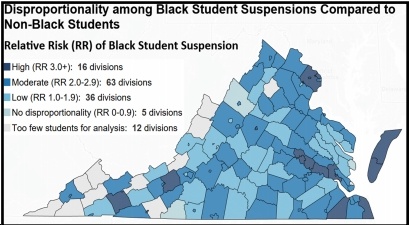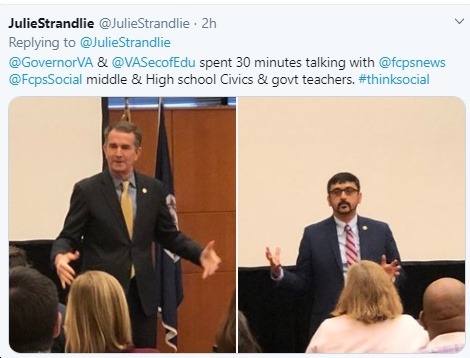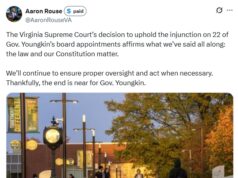 This month’s edition of the Virginia Department of Educations’ Quarterly Research Bulletin – click here or see it embedded, below – looks at a very important issue, namely “the school-level relationship between teachers’ race and rates of exclusionary discipline, particularly among Black students.” A few key findings of the bulletin are as follows (bolding added by me for emphasis):
This month’s edition of the Virginia Department of Educations’ Quarterly Research Bulletin – click here or see it embedded, below – looks at a very important issue, namely “the school-level relationship between teachers’ race and rates of exclusionary discipline, particularly among Black students.” A few key findings of the bulletin are as follows (bolding added by me for emphasis):
- “In Virginia, 16 of 132 school divisions reported a rate of suspension for Black students three times higher than rates of suspensions for non-Black students,” with another 63 divisions showing rates 2.0-2.9 times higher, and another 36 divisions showing rates 1.0-1.9 times higher. Only 5 divisions out of 132 show no “disproportionality” among Black student suspensions compared to non-Black students at all.
- This disproportionality is in spite of the fact that “[r]esearch does not support the idea that students of color are more likely to engage in problem behavior.“
- “There is no single solution to reduce discipline disproportionality. Previous research, combined with data from Virginia schools, supports the theory that increasing the racial diversity of the teacher workforce is a promising strategy.”
- “Diversifying the teacher workforce is one policy strategy that may reduce exclusionary discipline and boost academic achievement. Teachers of color produce outcomes that are more favorable for students of color on standardized test scores, attendance, advanced course enrollment, and college-going rates.”
- “Students’ exposure to same-race teachers is also associated with reduced rates of exclusionary discipline for Black students.”
- “While the teacher-student demographic gap in Virginia remains large—82 percent of teachers identify as white while only 48 percent of students do—local diversity has improved. In the past two years, more than half of Virginia’s school divisions have improved their minority student-to-teacher ratio. Additionally, the number of school divisions with no non-White teachers has decreased by 33 percent.”
- “Schools with higher Black student suspension rates are more likely to have a higher overall student suspension rate, higher student poverty, serve secondary grades, and be located in an urban setting. The model also suggests that schools with lower Black student suspension rates are more diverse. Schools in Virginia with higher percentages of Black teachers and Black students suspend a [lower] percent of Black students.”
Fascinating stuff, and it made me curious to find out more. So I ended up talking with my friend Atif Qarni, who is Virginia Secretary of Education, for a while about this topic. Not surprisingly, given his intense focus on and expertise in education, Secretary Qarni had a lot of thoughts. But first, check out the following tweets, about Qarni and Gov. Ralph Northam “spen[ding] 30 minutes talking with [Fairfax County Public Schools] middle & high school Civics & govt teachers” earlier today “during their State Govt in Action visit to Richmond” earlier today.


One thing from that photo which jumps out is the relative lack of racial and ethnic diversity. Why is this the case? Secretary of Education Qarni talked about this, as well as the exclusionary discipline report, in our lengthy conversation earlier this afternoon. Here are some highlights.
- According to Secretary Qarni, there definitely is a lack of diversity in teaching, particularly in areas like social studies and history. Why is this? Is it being fixed? What is the state government doing about this?
- Secretary Qarni – who, by the way, is an immigrant from Pakistan, a U.S. Marine (and Iraq War veteran), and a former teacher of civics, economics, U.S History, and mathematics at Beville Middle School in Prince William County – repeatedly emphasized the importance of diversity…for several reasons.
- Qarni talked about his own experience as a teacher, at a Prince William County school where nearly half the student population is immigrant, and how students were able to relate to him as an immigrant from South Asia who had also faced the challenges of mastering English as a second language.” According to Qarni, that background enabled him to relate to students in different ways, while the students could relate to a teacher who faced some of the same struggles they were facing. Also, Qarni’s teaching of history would bring in examples from civil rights and social justice movements in this country (e.g., Cesar Chavez and the United Farm Workers Union; the fact that much of the labor on the U.S. rail system was Chinese-Americans) as well as around the world.
- According to Qarni, white teachers can absolutely do the same types of things as mentioned above, but having more diversity among teachers “increases the likelihood” that this will occur. And, in the end, Qarni reports that kids were really excited and engaged about learning history in this way – e.g., not through an exclusively white, Eurocentric lens. Qarni added that “it’s about relevance” to the kids, and that if we teach history in a more diverse way, it might excited more diverse people to go into history and social studies.
- Of course, as Qarni pointed out, lack of diversity in teaching is not only a problem in social studies and history, but also in math, science, etc. But it’s more pronounced in social studies and history.
- This lack of diversity is also not confined to one area of Virginia, but is the case across the state.
- Qarni emphasized that many white teachers are doing a great job, including working hard to relate to and best serve their diverse students. Qarni specifically cited Fairfax County’s Social Studies Coordinator Colleen Eddy, who is white, as “very impressive” in this regard. So, in no way/shape/form is any of this about blaming the white teachers; it’s 100% about the benefits to increased diversity among teachers.
- There’s also the issue of low teacher salaries, which might make it more difficult for those without “generational wealth” or who, for other economic reasons, can’t afford to go into this field. Does that lead to less diversity in the teaching profession?
- Getting back to the exclusionary discipline report, Secretary Qarni said that teachers from diverse racial backgrounds tend to more frequently use strategies outside of writing discipline referrals. And that is certainly backed up by the data in the report, which found that “Schools in Virginia with higher percentages of Black teachers and Black students suspend a [lower] percent of Black students.”
- Another advantage to having more diversity among teachers, according to Secretary Qarni, is so that students of color can see role models for themselves, including potentially going into the teaching profession.
- What is the state doing about the racial “disproportionality” situation? According to Secretary Qarni, that includes initiatives like this one – “Governor Ralph Northam today highlighted his proposed $1 million investment to increase pathways for students to become science, technology, engineering, and mathematics (STEM) educators at Virginia’s two public historically black colleges and universities (HBCUs) through the national UTeach program.” It also includes tuition assistance that prioritizes teachers of color and teachers in high-need areas (e.g., STEM, special ed).
- There’s also the African-American History Education Commission, whose goal is “reviewing Virginia’s history standards, and the instructional practices, content, and resources currently used to teach African American history in the Commonwealth; and with examining and make recommendations on the professional development supports needed to equip all teachers for culturally competent instruction.” Secretary Qarni is very excited about this commission and what changes, for the better, it might lead to.
- On this same note, Secretary Qarni argues that “Black history should NOT start with slavery, but with 1000s of years of [history] before that.” As Qarni explains, African Americans were skilled laborers who were enslaved, but we don’t teach that history…and we should! Part of the answer here is to bolster Historically Black Colleges and Universities (HBCUs)…
- Finally, just to highlight the difficulties that currently exist in terms of diversity in this teaching arena, Secretary Qarni had a great quote: “It was easier for me to become Secretary of Education than to become a school principal or administrator, given my racial background.” To me, that’s an amazing quote, as it encapsulates so much of the challenge we’re facing here. In the case of becoming a principal or administrator, as Qarni explains, it’s all about the “pipeline” of teachers being “diversity limited” and, at present, mostly white. That situation, clearly, needs to change…and Secretary Qarni is working on doing just that.




![[UPDATED with Jim Ryan’s Letter] In Response to Youngkin’s “Sad, Whiny” Letter to Spanberger About UVA, VA Senate Majority Leader Surovell Says He’s “truly embarrassed for Gov Youngkin…After 4 yrs he has no understanding of basic VA govt structure”](https://bluevirginia.us/wp-content/uploads/2025/11/youngkinspanuva3-238x178.jpg)








